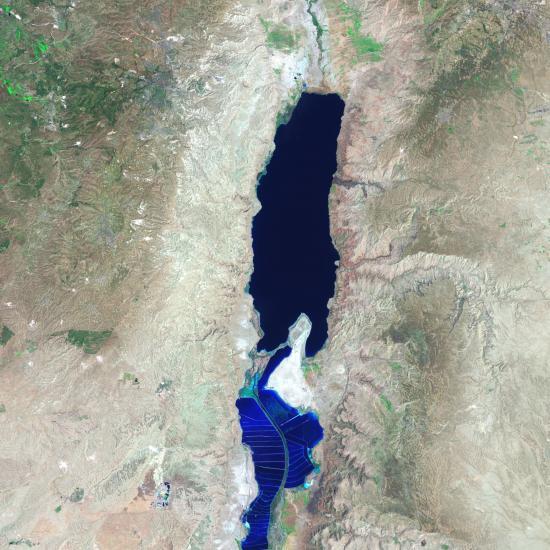Archaeologists Unearthing Major City-State in Western Jordan
Dan McLerran
Source - http://popular-archaeology.com/issue/june-2011/article/archaeologists-unearthing-major-city-state-in-western-jordan
Archaeologists are uncovering the remains of a human settlement that may vastly expand our knowledge of ancient civilization in Jordan's rich agricultural land of the southern Jordan River Valley.

A typical day at the site of the Tall el-Hammam excavations. Photo Credit: Michael Luddeni, Tall el-Hammam Excavations Project
Approximately 14 kilometers northeast of the Dead Sea, in the southern Jordan River Valley, lies a very large, imposing tall (mound). Surveys and recent excavations have revealed that the tall consists of a long history of human occupation dating back from Islamic times to at least the Chalcolithic period (4500 - 3600 B.C.E.). Sometimes referred to as the "Queen of the Southern Jordan Valley", it is the largest of a group of ancient sites that collectively dot this fertile, agriculturally developed valley.
Located astride ancient trade routes and water sources, along with a commanding view of the area identified by a number of scholars as the Jordan Plain, it is no wonder that the site evidences remains of a major ancient city. Archaeological investigations have revealed that the site is ringed by a 6-meter thick wall dating to the Early Bronze Age (3600 - 2350 B.C.E.), with mudbrick and packed-earth ramparts, including, on the top of the tall, monumental ruins of the Iron Age II and III periods that are also surrounded by 3-meter-thick city walls.
Since 2005, Dr. Steven Collins and a team of archaeologists, students, and volunteers from Trinity Southwest University, in conjunction with the Department of Antiquities of the Hashemite Kingdom of Jordan, have conducted full-scale excavations at the site of Tall el-Hammam. These excavations have revealed, in addition to the monumental features already mentioned, refurbished fortifications dated to the Intermediate Bronze period (2350 - 2000 B.C.E.), massive Middle Bronze (2000 - 1550 B.C.E.) fortifications up to 50 meters thick with a city wall and mudbrick and packed earthen ramparts, Iron Age (1300 - 600 B.C.E.) ruins with a chambered gateway and flanking towers, and Hellenistic, Roman and Byzantine structures that include a palatial residence, aquaduct, water system or bath complex, and what may be the remains of military garrisons.

Credit Michael Luddeni, Tall el-Hammam Excavations Project
The site (see its immense mound, right), with its strategic location and surrounding "satellite" ancient towns, is revealing what archaeologists are now interpreting as the epicenter of a large city-state complex that flourished during the Early, Intermediate, and Middle Bronze Age Levant, commanding commerce and possibly wielding influence over a broad swath of the southern Jordan Plain, or "Jordan Disk" area, as it is called. The research is opening up a treasure trove of new information that will shed fresh light on an area that has left archaeologists with unanswered questions for years. "Neither the Early Bronze Age nor the Middle Bronze Age is well-documented in the southern Jordan Valley on the east side of the river," states a project writer, "The excavation of Tall el-Hammam is filling in significant elements in our knowledge gap for both the Bronze Age and Iron Age in the Jordan Disk."
What most distinguishes the site from others of its kind, however, is the evidence that points to a remarkable resilience of the ancient city to the climate changes that occurred during the Levantine Early Bronze Age, changes that adversely effected many flourishing civilizations or cities in the Levant at the time. In addition, and perhaps most mystifying of all, is the city-state's sudden destruction and demise at the end of the Middle Bronze Age, followed by a 500-700 year gap when the site and its satellite towns remained unoccupied while cities to the west, north and east continued into the Late Bronze Age. States a key researcher: "Why the "well-watered plain of the Jordan" repelled reoccupation for so many centuries remains a mystery. That the most productive agricultural land in the region, which had supported flourishing civilizations continuously for at least 3,000 years, should suddenly relinquish, then resist, human habitation for such a long period of time begs investigation."

The site of Tall el-Hammam in this satellite photo is located in the lush green area just northeast of the northern tip of the Dead Sea. NASA Satellite Photo
An intriguing possibility highlights the fascination surrounding the excavations of this site: One may recall the Old Testament story that comes to mind about Lot and the infamous cities of Sodom and Gomorrah. Their actual locations on the archaeological landscape have long been the subject of scholarly debate. Many scholars are suggesting that the textual and archaeological evidence may indeed support the hypothesis that the remains of Tall el Hammam represent the remnants of the ancient city of Sodom. This suggestion is further documented in the Tall el-Hammam Excavation Project's Season Report for 2010.
Time and further research and excavation may shed more light. Whether the emerging evidence points for or against, however, is an aside to the valuable information that will be collected from this site about the role and influence of this major ancient city on the surrounding socio-economic and cultural environment, and the lifeways of the people who inhabited this location for thousands of years.
Archaeologists plan to return to the site to continue excavations in January of 2012.
More detailed information about the Tall el-Hammam excavations and discoveries can be found at the Tall el-Hammam Excavations Project (TeHEP) website.